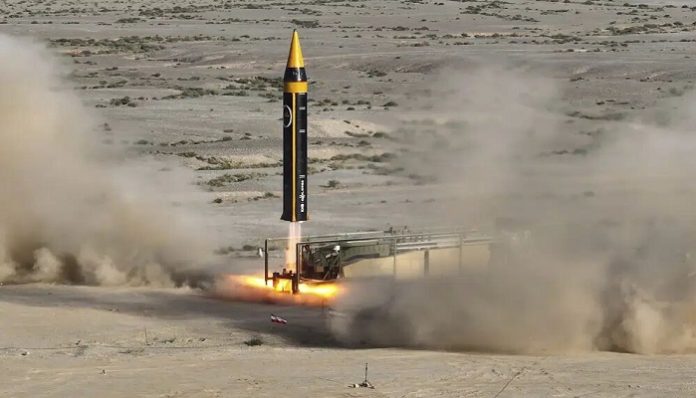Pak Sahafat – Channel 12 of the Zionist regime evaluated the unveiling of the Khorramshahr 4 (Khyber) missile by the Islamic Republic of Iran as containing a timely and warning message from Iran to this regime about committing any kind of adventure.
According to Pak Sahafat News Agency’s report, after the unveiling of the Khorramshahr 4 long-range missile, the media of the Zionist regime analyzed the technical and military capabilities of this missile and its role in the deterrence doctrine of the Islamic Republic of Iran.
These media have considered the unveiling of this missile at such a time as two parts of this doctrine, which, according to them, was done in order to neutralize the threats of the Zionist regime and deter elements against any adventurism of this regime.
Channel 12 of the Zionist regime reported: The new ballistic missile that Iran introduced on Thursday, whose range reaches Israel, raises the question of what is the logic behind this unveiling and why it is being done at such a time?
Regarding the timing of Iran’s unveiling of Khorramshahr 4 ballistic missile, he also said that the main issue lies in this timing. Iranians are aware of the positions and words that are said in “Israel”, and one of the signs of this is the unveiling of such a missile in such a period of time.
In this regard, Hamo pointed to the statements made a few days ago by the head of the Joint Chiefs of Staff of the Zionist regime, Hertsi Halifi, who spoke about the possible attack of this regime on the peaceful nuclear centers of Iran.
This analyst said: Iranians hear these words and by unveiling such a missile, they respond to us and send a deterrent message to any Israeli adventure.
Following the warnings of the pillars of the resistance to the Zionist regime and the re-empowerment of the Islamic Republic of Iran by testing the new Khyber ballistic missile, the leaders of the Zionist regime retreated from their rhetoric against Iran and the resistance in the region in recent days.
A military spokesman of the Israeli regime implicitly retreated from the rhetoric of Zionist leaders in recent days, including “Herzi Helivi”, the chief of staff of the Zionist regime, against Iran and the axis of resistance, which had caused a sharp decrease in the value of the currency of this regime, and said: Helivi’s statements do not mean that we are looking for a war against Lebanon or an attack on Iran.
Read more:
He also added, fearing the reaction and response of the resistance axis to the military maneuvers and movements of this regime in the coming days: Our military exercises are annual.
On the occasion of the 3rd of June, the anniversary of the liberation of Khorramshahr, Khorramshahr 4 missile named “Khyber”, the newest missile product of the Defense Ministry’s Aerospace Industries Organization, was unveiled on Thursday morning in the presence of Brigadier General Mohammad Reza Ashtiani, Minister of Defense and Armed Forces Support.
The Khyber missile, which is the newest version of the Khorramshahr missile family, is a liquid fuel with a range of 2,000 km and a 1,500 kg warhead, which, in addition to having strategic features, also has tactical features.
Among the salient features of Khorramshahr missile is having a guidance and control system in the middle phase of the flight, the use of this system and guidance engines in the warhead leads to controlling the condition and correcting the trajectory of the warhead outside the atmosphere, and practically all the guidance and control of this missile is takes place outside the earth’s atmosphere.
This feature leads to the fact that Khorramshahr 4 or Khyber does not need the activity of the guidance and control system in the atmosphere and thus is completely immune to electronic warfare attacks.
Another advantage of this guidance and control process is that the warhead of the Khorramshahr 4 missile does not need control beams, which reduces the weight of the systems required in the warhead and increases the weight of the propellant materials.
After the signing of the “Comprehensive Program of Joint Action” or the JCPOA, between Iran and the 5+1 including the United States, England, France, Russia, China and Germany, the United Nations Security Council (July 20, 2015), with an overwhelming majority, 15 positive votes from 15 members approved Resolution 2231 to approve this agreement to resolve some of the missile and weapons issues along with the JCPOA.
Based on this, a five-year limit was set for arms exchanges, an eight-year limit for missile activities, and a decade-long limit for nuclear activities.
Based on paragraph 5 of Appendix B of the resolution, after five years of the implementation of the agreement, Iran could buy and sell weapons; The restriction that ended at the end of October 2019, despite the increasing disruptions of the Western-Hebrew-Arab axis, and now we are on the verge of the end of the eight-year missile restrictions on Iran, which is supposed to end in October 2023.


